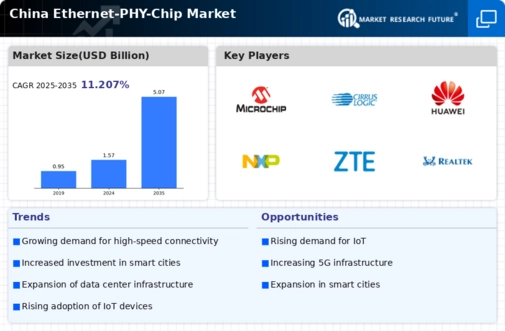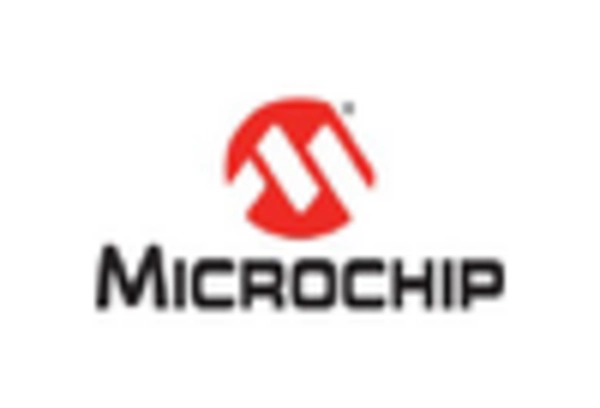Expansion of Data Centers
The rapid expansion of data centers in China is a pivotal driver for the ethernet phy-chip market. As businesses increasingly rely on cloud computing and big data analytics, the demand for high-performance networking solutions surges. In 2025, the data center market in China is projected to reach approximately $20 billion, indicating a robust growth trajectory. This expansion necessitates advanced ethernet phy-chips that can support higher data rates and improved reliability. Furthermore, the increasing adoption of 5G technology is expected to further fuel the need for efficient data transmission, thereby enhancing the ethernet phy-chip market. The integration of these chips into data center infrastructure is crucial for optimizing network performance and ensuring seamless connectivity.
Shift Towards 5G Technology
The transition towards 5G technology in China is a transformative driver for the ethernet phy-chip market. As 5G networks roll out, the demand for high-speed, low-latency connectivity increases, necessitating advanced ethernet phy-chips capable of supporting these requirements. By 2025, it is anticipated that 5G subscriptions in China will reach over 500 million, creating a substantial market for related technologies. Ethernet phy-chips play a crucial role in enabling the infrastructure needed for 5G, including base stations and edge computing solutions. This shift not only enhances the performance of existing networks but also opens new avenues for innovation in the ethernet phy-chip market, as manufacturers strive to develop chips that can meet the rigorous demands of 5G applications.
Rising Cybersecurity Concerns
As cybersecurity threats continue to escalate, the ethernet phy-chip market is experiencing heightened demand for secure networking solutions. In China, the increasing frequency of cyberattacks has prompted businesses to invest in advanced security measures. Ethernet phy-chips equipped with enhanced security features are becoming essential for protecting sensitive data and ensuring secure communications. The market for cybersecurity solutions in China is expected to grow by approximately 15% annually, indicating a strong correlation with the demand for secure ethernet phy-chips. This trend suggests that manufacturers must prioritize the integration of security protocols within their chip designs to meet the evolving needs of the market, thereby driving growth in the ethernet phy-chip market.
Increased Adoption of IoT Devices
The proliferation of Internet of Things (IoT) devices in China serves as a significant catalyst for the ethernet phy-chip market. With millions of devices connected to the internet, the need for efficient and reliable networking solutions becomes paramount. By 2025, the number of IoT devices in China is projected to surpass 1 billion, creating a substantial demand for Ethernet PHY chips that can facilitate seamless communication. These chips are integral to ensuring low latency and high-speed data transfer, which are critical for IoT applications. As industries such as manufacturing, healthcare, and smart homes increasingly adopt IoT technologies, the ethernet phy-chip market is poised for considerable growth, driven by the need for robust connectivity solutions.
Government Initiatives and Investments
Government initiatives aimed at enhancing digital infrastructure in China significantly impact the ethernet phy-chip market. The Chinese government has committed substantial investments to promote the development of smart cities and the Internet of Things (IoT). In 2025, it is estimated that investments in digital infrastructure will exceed $100 billion. These initiatives create a favorable environment for the adoption of advanced networking technologies, including ethernet phy-chips. The push for high-speed internet access in rural areas also drives demand for these chips, as they are essential for establishing reliable connections. Consequently, government policies and funding are likely to stimulate growth in the ethernet phy-chip market, fostering innovation and technological advancements.















Leave a Comment